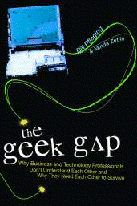As Minda and I discussed in
The Geek Gap, the concept of a destructive communication gap between the creators of a technology and the users of the tech is not restricted to modern times. One such possible group who suffered from this phenomenon is the Norse Vikings who colonized Greenland in the 11th to the 15th centuries.
They called it Greenland because it was a lush, wonderfully productive place in the 11th century, warm and perfect for farming. Grass for animals was plentiful, and huge schools of cod were in abundance. They colonized Greenland in the 11th and 12th centuries, growing to 3,000 colonists on about 300 farms in the mid-12th century.
But the climate began to change around 1150 AD, and the northern regions began to get colder, the summers shorter, and the winters harder and longer. By the 13th century the freeze really set in - the sea around the settlements began to fill with float ice, and then to freeze solid, causing the cod to migrate elsewhere. More than five centuries of colder weather decended on Northern Europe, and is today called the "
Little Ice Age."
The Norse colonists found it harder to produce enough food, depending more and more on trade from home, while at the same time fewer ships made the ever more treacherous trip, and the Vikings began to starve. By the middle of the 15th century, Greenland was no longer the beautiful green place it had been, the lush grasses replaced by ice sheets, and the waters formerly teeming with cod were now frozen most of the year. After centuries of harsh winters and long periods of deprivation and isolation, the Vikings had died out in Greenland.
The really strange thing is at the same time the Vikings were starving and freezing to death, nearby settlements of
Inuit tribes were thriving. Why would the same conditions cause vastly different results for these two cultures? The answer is - you guessed it - the Geek Gap.
The Inuit were master Arctic seamen and hunters, with weapons and methods honed to perfection over the millenia. Their harpoons were state of the art technology for hunting in the sea, with complex back-barbs, perfectly weighted shafts, and highly efficient delivery systems. This technology enabled them to successfully hunt and kill seals, walrus, and even the largest animals on the planet - whales. Their multi-layered system of well constructed fur clothing and igloo shelters made it possible for the Inuit to survive even the coldest weather.
By contrast, the Vikings hunting weapon of choice was a basic, crude spear, designed not as a hunting tool but as a weapon of war. While their spear was fine in hit-and-run raids on villagers, they were terrible at catching any kind of food. Their clothing was similarly designed to be used by a warrior, not a hunter. Warm for short runs into frozen towns to pillage, and light enough to allow for easy movement when fighting, but when it came to living for long extended periods in frozen climes, not nearly enough.
The big question that archaeologists ask is why, when the Vikings most certainly knew the Inuits quite well, didn't they learn from their obviously better equipped neighbors and survive? Unfortunately, it was the Vikings own pride that killed them.
They considered the Inuit to be lower beings, barely human, calling them "Kilinger" which means "ugly, little people" in Old Norse. They therefore did not respect or trust the Inuit, nor any of their methods, no matter how obviously superior they were. They simply couldn't bring themselves to use the Inuit technology.
In fact, the very superiority of the Inuit technology was what stopped the Vikings. How could they admit that these half-human, fur-covered savages were smarter, or better, at anything? Their mistrust, lack of respect, and probable loathing for anything not Norse made them blind to the technology that could have saved them. To be fair, I'm sure the Inuit had sufficient reason to not trust or respect the Vikings, so weren't in a big rush to help them out. The Inuit survived, and the Norse died out.
Real communication between cultures that could have saved the Vikings was not achieved, thereby keeping Europe unaware of the American continents for centuries, which would have vastly changed history.
"...And we'll be saying a big hello to all intelligent life forms everywhere. And to everyone else out there, the secret is to bang the rocks together, guys."
----------
Hitchhikers Guide To The Galaxy by Douglas Adams



